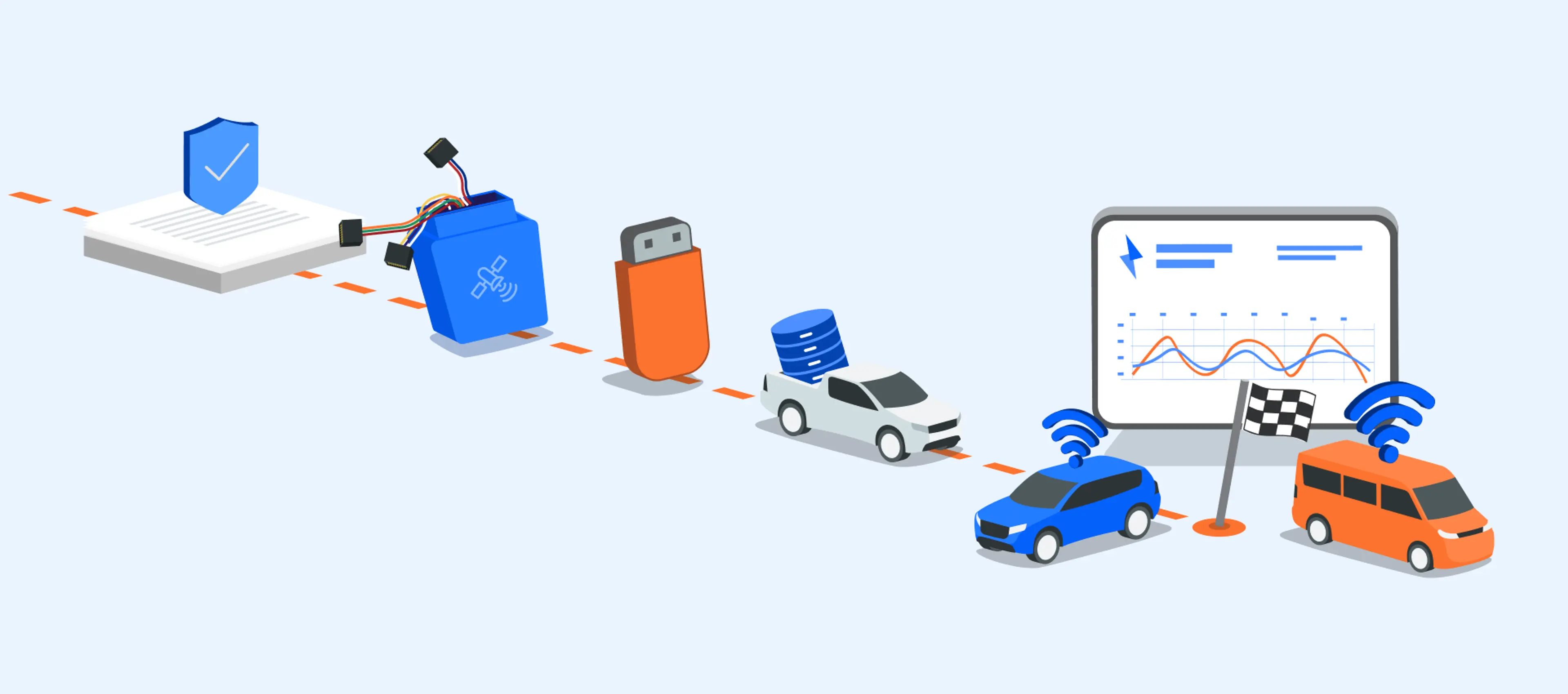The History of Embedded OEM Telematics: From Safety Button to Intelligence Platform

OEM telematics, the factory-installed systems that transmit data between vehicles and external services, have reshaped how transportation is managed. What began as an emergency communication feature in luxury cars is now a foundation of fleet operations and connected mobility.
Motorq estimates that 96% of vehicles manufactured in the US are natively connected. Understanding how OEM telematics reached this point reveals both the scale of technological progress and the remaining gaps in data access and standardization.
The early foundations: fleets before embedded connectivity
Long before automakers built telematics into vehicles, fleets pioneered its use. By the early 1990s, fleets across North America were using aftermarket GPS devices to improve route planning, monitor driver hours, and reduce idle time.
A key regulatory and technical milestone arrived with the OBD-II (on-board diagnostics) standard, which became mandatory for U.S. cars in 1996. The standardized port provided power and allowed devices to read engine fault codes and emissions data, paving the way for remote diagnostics. Although these aftermarket systems were costly and proprietary, they proved that data-driven fleet management could cut fuel use, prevent breakdowns, and improve safety.
The birth of embedded OEM telematics
The modern story of OEM telematics begins in 1996 with OnStar, introduced by General Motors on select Cadillac models. For the first time, vehicles came from the factory with a built-in cellular unit and GPS antenna that could automatically alert emergency services after a crash. It also supported features such as remote door unlock and stolen-vehicle recovery.
Other automakers quickly followed. Mercedes-Benz launched TeleAid in 1997 and BMW Assist launched in 1998, both offering similar crash response and concierge functions. These systems were primarily marketed as luxury features rather than fleet tools. Data access was limited, and the services were proprietary and subscription based.
In 1998, Qualcomm also introduced OmniTRACS, a satellite-based system that allowed long-haul trucks to transmit location and messages to dispatch centers.
This era marked a turning point. It proved that connectivity could save lives, creating the public expectation that vehicles should be able to “call for help” on their own.
The 2000s to early 2010s: expansion and fragmentation
As mobile networks improved, telematics shifted from premium options to mid-range offerings. Automakers began embedding modems and GPS chips across more vehicle lines.
The result was progress and fragmentation in equal measure. Each automaker built its own portal and data format, which meant fleets operating mixed brands faced multiple dashboards and download procedures.
By the end of the 2010s, connectivity was widespread but inconsistent. Most fleets still managed data through siloed systems.
The modern era: from hardware to data ecosystems
The late 2010s and early 2020s marked a decisive shift in OEM embedded telematics. Connectivity became standard on nearly every new vehicle, and automakers began opening secure data channels to partners and customers. Instead of relying on plug-in devices, fleets could access data directly from the OEM cloud. This created a data-as-a-service (DaaS) model in which odometer readings, diagnostic codes, location, and fuel status could be retrieved through web APIs rather than physical hardware. The result was lower installation costs for fleets and new digital revenue streams for automakers.
Progress introduced new challenges. Each OEM continued using its own data structures and signal names, which made cross-brand analytics difficult. A mixed fleet of Ford, GM, and Stellantis pickups could require three separate integrations, and the resulting data often could not be compared without custom work. As more connected vehicles entered the market, fragmentation became a barrier to realizing the full value of embedded telematics.
Platforms such as Motorq emerged during this phase to bridge these gaps. Motorq connects to multiple OEMs through secure APIs, normalizes the incoming signals into a single model, and delivers analytics-ready data to fleet systems. This allows operators to use factory-installed connectivity across brands through one platform and removes the need for aftermarket hardware in most scenarios.
Looking ahead: from data connectivity to connected vehicle intelligence
The next phase of OEM telematics will center on intelligence. Artificial intelligence and machine learning are already turning vehicle data into predictive insights, such as identifying maintenance needs before breakdowns occur or optimizing routes for energy efficiency.
Edge computing will allow vehicles to process data locally for faster responses to safety events, while 5G networks will enable real-time coordination with infrastructure and other vehicles. As connected vehicle intelligence becomes standardized and accessible, fleets will be able to merge it with enterprise systems for maintenance, logistics, and sustainability reporting.
Connectivity is now universal. The next frontier lies in how fleets, automakers, and technology partners use that connectivity to create value. Motorq helps fleets harness this data through a unified, analytics-ready platform that turns OEM connectivity into practical intelligence.
to learn how connected vehicle intelligence can power your fleet operations.